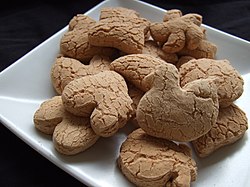|
Kue bangkit
Kue bangkit is a small biscuit (kue or kuih) in Malay cuisine made from sago starch,[2] commonly found amongst the Malay communities in Brunei, Indonesia, Malaysia and Singapore.[1] This biscuit has various colours, ranging from white, yellowish to brown, depending on the additional ingredients. In Indonesia, kue bangkit is associated with the Malay community of Riau[8] and Riau Islands provinces.[9][1][2] While in Brunei, Malaysia and Singapore, kuih bangkit is associated with both the Malay and Chinese communities.[10] It is one of the typical traditional cookies often consumed during Hari Raya and Chinese New Year.[3] The biscuit is also consumed in other countries under different names; in Thailand (especially Southern Thailand), it is known as Khanom Ping while in Vietnam, these tapioca cookies are known as Banh Phuc Linh. These cookies are commonly served during the Lunar New Year in these countries. EtymologyThis coconut sago cookie is called as kue bangkit in Indonesia, and kuih/kueh bangkit in Malaysia and Singapore. The term bangkit in Malay language means "rise" refer to the fact that the biscuit expands twice the size after baking.[1][10] IngredientsKue bangkit ingredients consists of sago or tapioca starch, thick coconut milk, sugar, egg yolks, pandan leaf, margarine and salt. Sometimes vanilla extract and gula aren (palm sugar) might be used for a better aroma.[8] The texture of the kue bangkit is very crispy and tends to be brittle. The dough is molded using small cookie molds, and subsequently the cookies being baked using oven. Eating this cake will give the sensation of melting in the mouth. However, the texture remains crispy when chewed. Kue bangkit has a sweet and savory flavour. VariationsIn Singapore, its McDonald's outlets released desserts inspired by the biscuit's taste in the country, including Kueh bangkit-flavoured McFlurry, sundae, and soft serve.[11][12] See also
References
External linksWikimedia Commons has media related to Kue bangkit. |
||||||||||||||||
